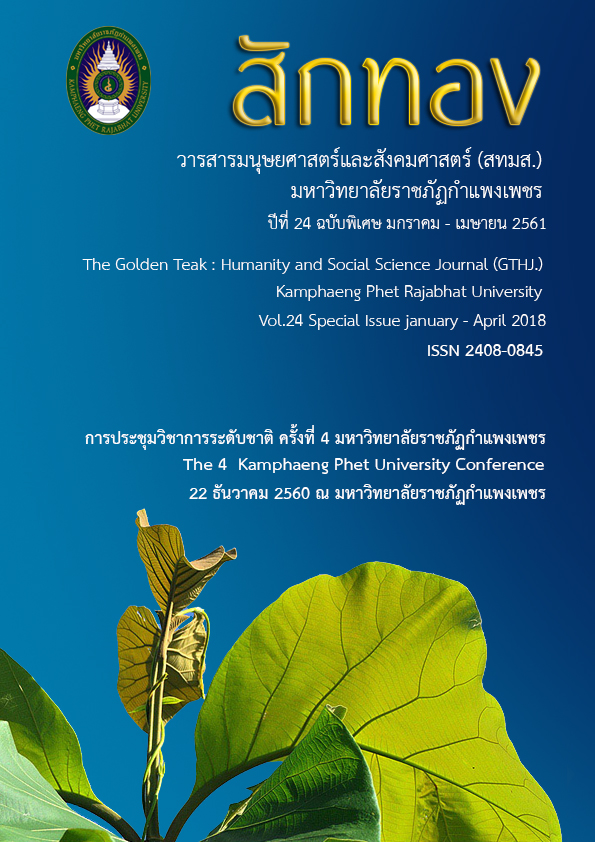Media Literacy in Social Media
Main Article Content
Abstract
Present, Social media take an important role of media exposure which effected to the media. Press should be competitive with social media. Eventhough some of information in social media is incorrect. Media Literacy is a very important tool in social media era. A person in Media Literacy should have these skills : Access, Analyse, Evaluation, Content Creation, Conduct, Act and Participate. Media Literacy for people requires collaboration from all sectors of society ; Family, School or University, Government sector, media and audiences. So that people can be exposed to news and have a Media Literacy skills.
Article Details
บทความที่ได้รับการตีพิมพ์เป็นลิขสิทธิ์ของวารสาร สักทอง : วารสารมนุษยศาสตร์และสังคมศาสตร์ สถาบันวิจัยและพัฒนา มหาวิทยาลับราชภัฏกำแพงเพชร
ข้อคิดเห็นใดๆ ที่ปรากฎในวารสารเป็นวรรณกรรมของผู้เขียนโดยเฉพาะ ซึ่งมหาวิทยาลัยราชภัฏกำแพงเพชรและบรรณาธิการไม่จำเป็นต้องเห็นด้วย
References
Subject of Leadership and Contemporary Management. The Golden Teak :
Humanity and Social Science Journal, 22(4), 114-123.
Eristi, B. & Erdem, C. (2017). Development of a Media Literacy Skills Scale. Contemporary
Educational Technology. 8(3), 249-267.
Hobbs, R. (2010). Digital and Media Literacy : A Plan of Action. Communications and Society
Program, The Aspen Institute.
Jerasophon, P. (2016). Communication Literacy in Digital Age and Its Role in Guiding the
Direction of Communication Reform in Thai society. Research Paper, Dhurakij
Pundit University.
Livingstone, S. (2004). Media literacy and the challenge of new information and
communication technologies. The Communication Review, 1(7), 3-14.
Makesrithongkum, B. (2011). Media Literacy: Keeping Pace with Information Age. Executive
Journal, 31(3), 117-123.
Newman, N. (2009). The rise of social media and its impact on mainstream journalism :
A study of how newspapers and broadcasters in the UK and US are responding
to a wave of participatory social media, and a historic shift in control towards
individual consumers. Working Paper. Reuters Institute for the study of Journalism.
Office of The National Broadcasting and Telecommunications Commission and Faculty of
Communication Arts Panyapiwat Institute of Management. (2016). User-Generated
Content Guideline in Broadcast News Reporting. Project of Using Information from
Online Media in Media Convergence Era.
O’Neill, B. & Barnes, C. (2008). Media Literacy and the Public Sphere : A Contextual Study
for Public Media Literacy Promotion in Ireland. Center for Social and Education
Research, Dublin Institute of Technology.
Potter, W. J. (2010). The State of Media Literacy. Journal of Broadcasting & Electronic Media,
54(4), 675-696.
_______. (2014). Media Literacy. (7 th ed.). London : Sage.
Ruampum, K. (2015). The Role of Thai Higher Education Institutions to Create Media Literacy in
Thai Society. Dhurakij Pundit Communication Arts Journal, 9(1), 79-99.
Rusmeeviengchai, A. (2013). Advertising Media Literacy of secondary students in
Chumchon Prachathipat Wittayakhan School. Research Project, Faculty of
Journalism and Mass Communication, Thammasat University.
Satitworapong, W. (2017). Change in Matichon Weekly April, 7-13, 2017. [Online]. Available :
https://www.matichonweekly.com/column/article_31336. [2017, July 23].
Tansuwannond, C. (2016). Enhancing Media Literacy is to Sustainably Develop the Quality of
Media and Media Consumers in Thai Society. The Journal Of Faculty Of Applied
Arts, 9(2), 89-97.
Vichitrboonyaruk, P. (2011). Social Media : Future Media. Executive Journal, 31(4), 99-103.
Williamson, A. (2013). Social Media Guidelines for Parliaments. [Online]. Available :
http://www.ipu.org/PDF/publications/SMG2013EN.pdf. [2017, July 16].
Yenjabok, P. (2015). Media Literacy of Thai Children : Wise, Intelligence Selective. Bangkok :
Culture Surveillance Bureau Office of the Permanent Secretary.
Yimprasert, U, Paladkong, N. & Siriumpankul, A. (2016). Benefits and Application of Media
Literacy : A Case Student of a Private Higher Education Institution. Panyapiwat
Journal, 8(2), 183-195.

